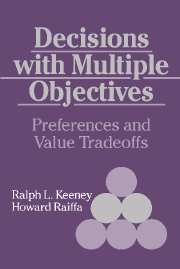Book contents
- Frontmatter
- Contents
- Preface to the Cambridge University Press Edition
- Preface to First Edition
- 1 THE PROBLEM
- 2 THE STRUCTURING OF OBJECTIVES
- 3 TRADEOFFS UNDER CERTAINTY
- 4 UNIDIMENSIONAL UTILITY THEORY
- 5 MULTIATTRIBUTE PREFERENCES UNDER UNCERTAINTY: THE TWO-ATTRIBUTE CASE
- 6 MULTIATTRIBUTE PREFERENCES UNDER UNCERTAINTY: MORE THAN TWO ATTRIBUTES
- 7 ILLUSTRATIVE APPLICATIONS
- 8 AIRPORT DEVELOPMENT FOR MEXICO CITY: A CASE STUDY
- 9 PREFERENCES OVER TIME
- 10 AGGREGATION OF INDIVIDUAL PREFERENCES
- Bibliography
- Index
Preface to the Cambridge University Press Edition
Published online by Cambridge University Press: 05 July 2014
- Frontmatter
- Contents
- Preface to the Cambridge University Press Edition
- Preface to First Edition
- 1 THE PROBLEM
- 2 THE STRUCTURING OF OBJECTIVES
- 3 TRADEOFFS UNDER CERTAINTY
- 4 UNIDIMENSIONAL UTILITY THEORY
- 5 MULTIATTRIBUTE PREFERENCES UNDER UNCERTAINTY: THE TWO-ATTRIBUTE CASE
- 6 MULTIATTRIBUTE PREFERENCES UNDER UNCERTAINTY: MORE THAN TWO ATTRIBUTES
- 7 ILLUSTRATIVE APPLICATIONS
- 8 AIRPORT DEVELOPMENT FOR MEXICO CITY: A CASE STUDY
- 9 PREFERENCES OVER TIME
- 10 AGGREGATION OF INDIVIDUAL PREFERENCES
- Bibliography
- Index
Summary
Way back in the mid-seventies when we wrote Decisions with Multiple Objectives, our objectives were clear. We aspired to develop a sound, practical theory for analyzing decisions with multiple, competing objectives; to make this theory and framework of thought accessible to a diverse audience of scholars and practitioners of the art of decision analysis; and to promote applications of multiattribute analysis. Today, our objectives are exactly the same. In the intervening sixteen years, the theory most relevant to applications has been augmented a little and the application of the theory has greatly expanded.
Decision analysis is widely recognized as a sound prescriptive theory. When a decision involves multiple objectives – and this is almost always the case with important problems – multiattribute Utility theory forms the basic foundation for applying decision analysis. The theory explicitly addresses the value tradeoffs and uncertainties that are invariably at the center of multiple-objective decisions. The experience of numerous applications indicates that the theory available in 1976 is still the most relevant theory available today. The important addition since 1976 concerns value functions that address strength of preferences between pairs of consequences (see Dyer and Sarin, 1979; Bell and Raiffa, 1988).
The art of applying multiattribute Utility has expanded in many directions since 1976. Collectively, decision scientists know much more today about identifying and structuring objectives and about measuring their achievement in terms of objectives. We are more skilled at assessing Utility functions, and Computer programs greatly assist analyses and sensitivity analysis.
- Type
- Chapter
- Information
- Decisions with Multiple ObjectivesPreferences and Value Trade-Offs, pp. xi - xivPublisher: Cambridge University PressPrint publication year: 1993
- 19
- Cited by

